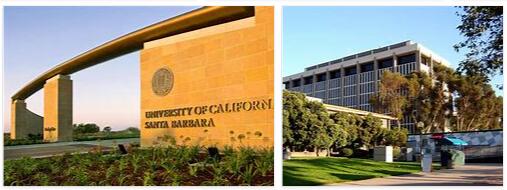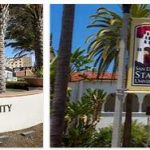- Why Santa Barbara?
Sun, sea, partying and studying at the same time. And depending on which courses you choose, the point of studying can take a back seat. The UCSB was first shortlisted for me because you have trimesters there, which makes it easy to leave in the summer semester, as many other universities are already starting while exams are still being written in Germany. The disadvantage of this is that you are not entitled to foreign student loans due to the shorter time. On the other hand, the tuition fees are still relatively cheap in the USA as a whole, whereas the cost of living is again somewhat higher.
If you want to study here, you have to make one thing very clear: UCSB is in principle always chosen among the top 10 American party universities and if you study there you will not be able to avoid it. That was extremely good in the first month in particular, but it can become a bit much over time. Therefore, the UCSB is especially for younger students. For those who are more advanced with their studies, UC San Diego is likely to be a better alternative.
- Check topschoolsintheusa for more about University of California Santa Barbara Rankings.
Those who study at UCSB have to live in the student town of Isla Vista, everything else makes no sense. It is right next to the university and you have everything you need for life in the immediate vicinity. There are parties here almost the whole week and there is always a lot going on on Del Playa, the street directly on the beach, especially on weekends. All of my friends who lived outside tried to move somehow, which was often too late.
Finding an apartment is not at all difficult in the summer semester, as many finish their studies shortly beforehand. The best thing to do is to look for some rooms in advance via http://santabarbara.craigslist.org/ so that you can move in as soon as you arrive. For the first week you can stay in the Tourist Hostel Santa Barbara (http://www.sbhostel.com/) and from there take the bus (http://www.sbmtd.gov/) to Isla Vista to take care of the apartment. In the hostel it is important that you lock up your valuables, nothing happened to me, but a friend who was there at the same time had her toiletry bag with jewelry stolen.
In order to coordinate the whole thing, you should get a cell phone as soon as you arrive, as it is difficult to make fixed appointments with the American students by email, they are usually a bit more spontaneous. The prepaid tariffs from Net10 or Tracfone are ideal here, as the costs per minute are around 10 cents, whereby in principle everywhere in the USA you pay when you are called or receive a text message.
For the way from LAX airport to Santa Barbara you can either take a sprinter bus for around $ 50, which takes about 3 hours and is relatively relaxed, or you first drive to Union Station and from there by train to downtown Santa Barbara, where you get right on Hostel works, you only pay about $ 30 but you have to worry about more.
- Economic courses
A basic distinction must be made between extension courses and academic courses. Extension courses are only for exchange students and people in the job who want to continue their education. At around $ 400, the courses are half the price of academic courses and are generally easier, but require attendance. However, you have to make sure that you take the courses at the UCSB and not at the branch offices in Ventura where you can only get there by car and drive about 1 hour. The disadvantage is that you are almost only with German students here, as there are an extremely large number of BA students due to a cooperation with the university.
The academic courses are a bit more demanding but still easy to master. There you also meet more local students and are forced to converse in English, which is in a way the goal of studying abroad. You have to note that the American students have priority over extension students, which is why you have to crash courses in the first week. That means you can first be put on the waiting list by the Economic Department for courses you might want to attend, here you can choose as many as you want. Then you attend the first lectures and then ask the professor whether he will let you into the course, he will then sign a form with which you go back to the Economic Department, which will then draw lots to see if you can join the course. Then you have to pay your course fees and you are finally firmly in the course. So it can take 2 weeks until you know which courses you are going to and you have to attend all lectures.
For all courses, you usually have to write a preliminary exam and often hand in homework. This has the advantage that the final grade not only depends on the final exam and you can push your grade up with homework.
- My courses:
Labor Economics (Academic): Relatively simple course on labor economics. If you are present in the lecture (with me Mon. Wed. Fri. at 9 am) and write with you, you shouldn’t have a problem to pass the course well. Since everything is built up in Borjas’ book, you can rework the theory very well, but you need the lecture to have all the formulas for the exams. In addition, the course is not so full that you can go straight into it.
Principles of Marketing (Extension): In the course you will gradually learn how to write a marketing plan. To do this, you have to hand in a homework assignment every week, which will later be part of the overall marketing plan that you have to submit instead of a final exam. Here, too, reworking is announced every week, which is made pretty easy with the accompanying book.
Financial Statement Analysis (Extension): The chillest course ever, provided you have Greg van Wyk as your instructor. I can only recommend. The content of the exams was always explained in detail the week before and you were allowed to take a double-sided sheet of paper with you to the exam. In principle I copied all the answers from it.
- What to watch out for
- No alcohol under 21 (If you are at private parties, that’s no problem as long as the party is not too blatant that the police will stop at some point, then it’s time to run)
- No open containers of alcohol on the street (over $ 200 fine, no exception)
- The same goes for peeing wildly
- Riding a bike while drunk is just as bad a idea as driving a car









